-
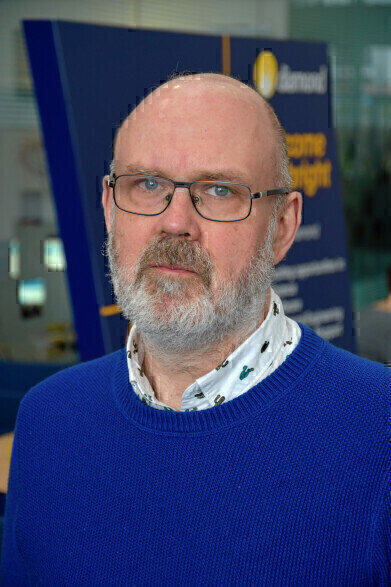 Professor Fred Mosselmans
Professor Fred Mosselmans -
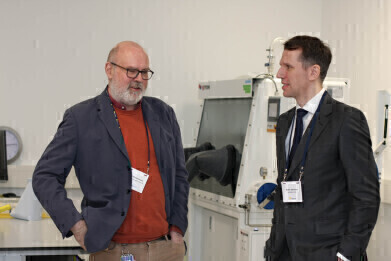 Professor Mosselmans with Robin Ibbotson in the AML
Professor Mosselmans with Robin Ibbotson in the AML -
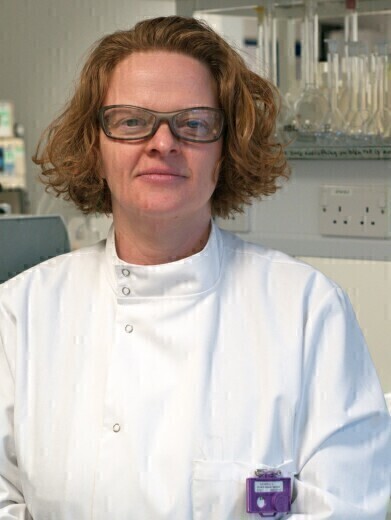 Professor Katherine Morris (credit K.Morris, Manchester University)
Professor Katherine Morris (credit K.Morris, Manchester University) -
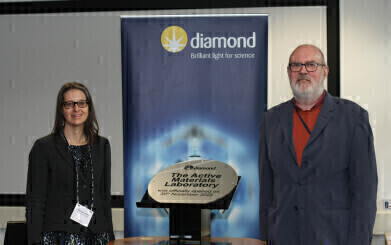 Professor Susannah Speller, and Fred Mosselmans
Professor Susannah Speller, and Fred Mosselmans -
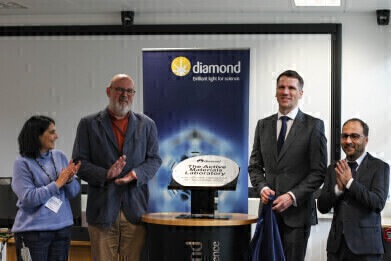 Sofia Diaz-Moreno, Science Group Leader of the Diamond Spectroscopy Group; Prof. Fred Mosselmans, Principal Beamline Scientist at Diamond; Dr Robin Ibbotson, Chief Technology Officer at Sellafield Ltd and Adrian Mancuso, Physical Science Director at Diamond at official opening of Activated Materials Laboratory
Sofia Diaz-Moreno, Science Group Leader of the Diamond Spectroscopy Group; Prof. Fred Mosselmans, Principal Beamline Scientist at Diamond; Dr Robin Ibbotson, Chief Technology Officer at Sellafield Ltd and Adrian Mancuso, Physical Science Director at Diamond at official opening of Activated Materials Laboratory -
.Credit_DiamondLightSource.jpg) Inside the Active Materials Lab
Inside the Active Materials Lab -
.Credit_DiamondLightSource.jpg) The Coy Chamber inside the AML
The Coy Chamber inside the AML
News & Views
AML launch at Diamond opens pathway to Active Experimentation
Dec 09 2022
Diamond Light Source, the UK’s national synchrotron, has celebrated the official launch of its dedicated Active Materials Laboratory (AML), which is set to enhance research into irradiated materials by those involved with nuclear facilities, waste disposal and remediation, as well those conducting unique sample analysis.
The new Laboratory was opened by Dr Robin Ibbotson, Chief Technology Officer, Sellafield Ltd and during the day there were also talks by Professor Claire Corkhill, University of Sheffield and Professor Katherine Morris, University of Manchester. These experienced users are already taking advantage of the many new opportunities the laboratory offers to advance their research into active and radioactive materials.
The first integrated handling facility of its kind at a synchrotron worldwide, the AML offers wet/dry laboratories and a counting room for characterising samples directly prior to beam line analysis. This has transformed what users can achieve on the beamlines; while teams from the Universities of Manchester, Bristol and Sheffield are conducting much of the active materials research on site, the new laboratory now provides opportunity for other users to move into ‘active’ experimentation, such as those from the materials department at the University of Oxford and other key researchers across the UK.
Principle Beamline Scientist, Professor Fred Mosselmans, said: “Previously we only had the capability to prepare samples with very low activity on-site. This made it hard for our user community to adjust their experiments. They now don’t need to go back and forth between their home university laboratories to reload their sample cells or reprocess their samples.”
Professor Mosselmans identified for our readers, the four main areas that independent research groups would be involved with;
a) Those looking at waste disposal of active materials; and those looking at effects of irradiation on structure and breakdown with regard to the environment. “Here there will be users looking at the behaviour of active materials in the environment and also looking at materials to encase actinides for long-term disposal. Also they will look at how, in the medium term, current storage conditions may alter some of these fuels and other actinide waste.”
b) Materials analysis - looking particularly at fuels in large and possibly small quantities
“The lab may encourage these studies, the samples will be small or normally very small, (prepared from larger samples elsewhere)”
c) Materials for new build- eg on steel and graphite - effects of strain on impaction and breakdown of irradiated materials
“This is the area the lab will help most as experimental rigs will be able to be loaded on site.”
d) Fusion - testing of new types of materials such as superconductors
Fission - testing of radioactive materials such as uranium.
“The lab has aided these studies (fusion) and will continue to do so. I don’t think it will aid the testing of nuclear fuel but it may contribute (as in b, the measurement of very small samples).”
While the above covers most of the work relating to the nuclear industry, it will also enable some more basic uranium (and other element) science, i.e. there is a user group looking at understanding better the electronic structure of uranium in solution with various ligands using X-ray emission spectroscopy. Also there are groups looking at the physics of actinide elements who the lab may also help, he added.
Researchers from the Materials Department at the University of Oxford, are using a combination of techniques to explore how radiation will damage the superconducting magnets essential for fusion tokamak power plants. Led by Professor Susannah Speller these particular experiments used REBCO (rare earth barium copper oxides) materials irradiated with He+ ions. Ion irradiation is often used as a proxy for neutron radiation, as it doesn't make materials radioactive. However, we don't yet know whether it produces the same defects in REBCO as neutron irradiation. To find out, Prof Speller's team is now working with REBCO samples irradiated in the TRIGA fission reactor in Vienna.
"At the AML, we were able to do some initial etching of the samples to remove unwanted layers and then put them into containment to transport them to the beamline," explains Prof Speller. "And then we could take them back into the AML, perform an anneal to test defect recovery and take them back to the beamline to examine the results. We were the first users at the AML and we can only investigate these neutron-irradiated materials because we have access to this facility."
The techniques most likely to be used by user groups on the beam lines include scanning X-ray absorption spectroscopy, including surface measurements to understand the local chemistry of actinides and other radioactive elements in lots of different environments; scanning X-ray emission spectroscopy, to understand the electronic structure of materials; micro and nano x-ray fluorescence and X-ray absorption near edge structure spectroscopy, to look at actinides (and technetium) in the environment e.g. in particles from around Fukushima; tomography; and small angle scattering to look at small particle formation from solutions.
Some of the advanced work in cell characterisation already carried out at AML has included high activity graphite samples loaded in cells (supplied by the user) suitable for measurement on I12 in the lab and annealing experiments on superconducting tapes which had been irradiated to see how the annealing helps recover the original structure by X-ray emission spectroscopy. An experiment looking at the absorption and reaction of H2 with UO2 (simulant fuel) to understand some of the possible reactions that might occur during the storage of spent fuel, is expected to take place shortly.
Diamond will also be providing a proven environment to test activated materials in the form of a new torsional rig for using quartz cells at temperature. Previously users wishing to conduct this sort of experiment would have to design their own set-up and then have it undergo a safety analysis before it could be used. With the TR6 rig users will only need to provide details on the samples and get it prepared to the correct dimensions as the new rig would have already been safety analysed and tested by Diamond.
Expected the end of this year, the TR6 rig is predicted to be in use within six months of coming on site; this will be used for testing non-active samples initially and all eventualities accounted for before active samples are used. “This may take several months; the lab work is not time-bound but testing on the beamline has to be fitted in with its full user programme. Hence late 2023 is likely to be the earliest date for active experiments with the set-up,” said Professor Mosselmans.
“There are a lot of materials used in Nuclear (fission) power stations such as graphite and Zircaloy that academics in the UK potentially have access to. These have been irradiated for some time in service and it is important for understanding the potential lifetime of power stations (exploiting the investment to the full, safely) and in designing new facilities,so that the effects of radiation on their structural properties are understood as well as possible. Currently a lot of conservative assumptions are made by testing these materials - it may be shown that these assumptions are too conservative and the materials will be safe longer, or that may not prove to be the case; but until actual analysis is done, that is not known,” said Professor Mosselmans.
Similarly, understanding the corrosion impact of radionuclide behaviour in encapsulated nuclear waste is essential to model and understand the future performance of the UK's proposed geological disposal facility; to do so requires intimate knowledge of the interaction of radionuclides with the materials used in the construction of the facility, he added.
Professor Sam Shaw, at the University of Manchester said: “Understanding structural change in materials due to operation and radiation damage is a major challenge for the nuclear industry and the academics working in this field. Scientific research is essential to provide evidence to aid decision-making. For instance, when reviewing ageing infrastructure and making a judgement on their lifetime or when designing brand new nuclear facilities.”
More information online
Digital Edition
ILM 49.5 July
July 2024
Chromatography Articles - Understanding PFAS: Analysis and Implications Mass Spectrometry & Spectroscopy Articles - MS detection of Alzheimer’s blood-based biomarkers LIMS - Essent...
View all digital editions
Events
Jul 28 2024 San Diego, CA USA
Jul 30 2024 Jakarta, Indonesia
Jul 31 2024 Chengdu, China
ACS National Meeting - Fall 2024
Aug 18 2024 Denver, CO, USA
Aug 25 2024 Copenhagen, Denmark

.jpg)

24_06.jpg)













